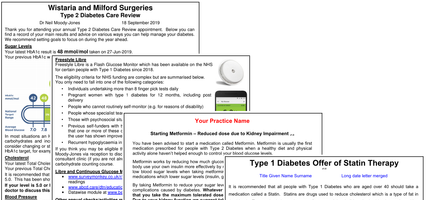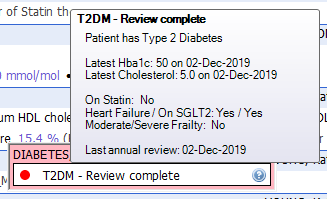Our Practice
At Wistaria and Milford Surgeries we have changed how we run our annual Diabetes QOF recall system. We have used features of EMIS web to make the process more efficient but also more personalised for patients.
Old system:
- Every patient invited for a 30 minute nurse appointment each year
- Type 1 and Type 2 Diabetes treated the same (same invite letters, same clinical template used at appointments)
- No written record of results routinely given to patients.
New system: running since April 2019
- Patients see either a nurse for 30 minutes or a Health Care Assistant (HCA) for 20 minutes based on their results and medical record
- Type 1 and Type 2 Diabetes treated differently (different invite letters, and clinical templates used at appointments)
- Mailmerge care plan provided with different versions for Type 1 and Type 2 Diabetes
- Other new documents produced for patients starting Statins and Metformin
Diabetes Alert Protocol
The Diabetes Alert Protocol is what is used to filter patients into Nurse or HCA appointments. It also produces alerts in the QOF box for all patients with Diabetes showing where they are in the annual recall process increasing the oppurtunities to suggest patients attend their reviews.
Before producing the alert protocol we needed to decide which patients we felt could be managed by an HCA (who received additional training to perform foot checks).
Patients to be offered an HCA appointment:
- Type 2 Diabetes only
- On no medication for Diabetes or just Metformin
- Hba1c <48 if on no medication
- Hba1c <53 if on Metformin
- Total Cholesterol <5
- Not previously had a high risk foot
- No history of Coronary Heart Disease (these would already be offered a 20 min HCA review so felt better to just see the nurse once)
- Should have had an annual review before i.e. not a new diagnosis
At the beginning of the QOF year one of these alerts are shown:
Those with others forms of diabetes recieve a third alert which I have left off here to reduce confusion.
Once invite letters are sent out the alerts automatically change to the following:
Once blood results are back the alerts change again:
At this point the patient phones in and the receptionists can see the alert and book the patient into the correct appointment. The protocol displays 20min HCA or 30min Nurse by interogating the patients record and blood results based on the filter above.
Once the patient has been in for their review the alerts change again:
When putting your mouse over any of the alerts above you get further information about the patient namely their last Hba1c, Total Cholesterol, Date of last annual review, whether on a statin or not and whether they have been coded as having moderate or advanced frailty.
On the right you can see an example of this. Now also with visibility regarding Heart Failure and SGLT2 use.
At the start of the next QOF year the system automatically resets and the process starts again.
Template Documents
Various template documents have been created most of which have versions available for download on this website.
The main focus was to create a care plan which would be merged at the appointment so as to include up to date height, weight, BMI and blood pressure readings. The care plans also show the patients most up to date Hba1c and Total Cholesterol readings as well as their previous reading. We also show the date they last had their eye screening performed.
The way we have implemented the care plans mean that we can actually have different versions and the correct version load for the patient. We have four different versions currently:
- Type 1 care plan BMI <25
- Type 1 care plan BMI >25
- Type 2 care plan BMI <25
- Type 2 care plan BMI >25
Those patients with a BMI of 25 or over get a different care plan with additional information about local weight loss services. Locally we have a weight loss CBT service available for those with a BMI of 25 or over (POWER) and Weight Watchers (WW) for those with a BMI of 28 or above. The care plan includes all the infomartion needed to make a self referral so no additional paperwork is needed.
Those patients not on a Statin are automatically forwarded to a Qrisk2 template during the annual review process. If this Qrisk2 score is of 10% or more then the protocol automatically offers an "offer of statin letter".
We have also produced a letter for those being started on Metformin which promotes patients being titrated to their maximum tolerated dose. We have two different versions of this document also with the correct version being loaded depending on the patients last eGFR. For those with an eGFR of 30-45 they are recommended a maximum dose of 500mg BD while those with an eGFR of >45 are suggested a maximum dose of 1g BD.
Annual Review Protocol
The Diabetes Annual Review Protocol ties everything together and is run at the annual review appointment instead of using a standard template.
On running the protocol a menu is produced and you then select the required option:
- Nurse appointment
- HCA appointment
- Other resources
- Quick links
- Admin Menu
If you click Nurse appointment then the protocol checks if the patient has type 1 or type 2 diabetes and takes you to the appropriate first template. Here height, weight, blood pressure and a foot check are performed as well as the collection of smoking and alcohol use. On saving this template the appropiate care plan is then lauched and printed. If the patient is aged over 40 and not on a statin then the Qrisk2 template opens. When this is completed if the Qrisk is >10% an offer of statin letter is offered. The protocol then opensa second template (different versions for type 1 and type 2 ) for documenting and further discussions. This second template contains some dynamic features like a section which only appears if the patient is using insulin needles if 6mm or more so as to remind the nurse to discuss switching to smaller needles.
If you click HCA appointment at the initial menu then you are first taken to a template where height, weight, blood pressure and foot check are performed as well as the collection of smoking and alcohol use. On saving this template the appropriate care plan is launched and printed. If the patient is aged over 40 and not on a statin then they are taken to a Qrisk2 template. If the subsequent Qrisk2 score is 10% or more then an "offer of statin leaflet" is printed. The consultation ends at this point. The HCA team is aware that the main focus of this apppointment is Blood Pressure as we know that their Hba1c and Total Cholsterol are good to have been offered an HCA appointment. If their blood pressure is over target they are offered home or ambulatory monitoring and a telephone consultation with their own GP to discuss the results.
The "Other resources" menu has links to commonly used documents like the podiatry referral form and clinical waste (sharps bin) referral. Clicking on "start metformin" lauches another protocol which checks eGFR and prints an appropriate document to give the patient with information on starting Metformin.
The "Quick links" menu has links to the various steps in the process so that if something needs documenting out of order you can jump to the relevant part of the process.
The "Admin menu" takes you to the annual review invitation letters which have also been completely rewritten to try and improve engagement.






